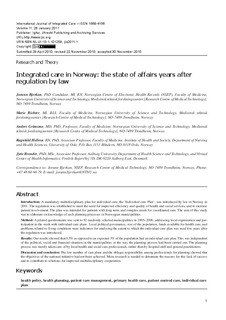Integrated care in Norway: the state of affairs years after regulation by law
Journal article, Peer reviewed
Permanent lenke
http://hdl.handle.net/11250/2353294Utgivelsesdato
2011Metadata
Vis full innførselSamlinger
Originalversjon
International Journal of Integrated Care 2011, 11Sammendrag
Introduction
A mandatory multidisciplinary plan for individual care, the ‘Individual care Plan’, was introduced by law in Norway in 2001. The regulation was established to meet the need for improved efficiency and quality of health and social services, and to increase patient involvement. The plan was intended for patients with long-term and complex needs for coordinated care. The aim of this study was to elaborate on knowledge of such planning processes in Norwegian municipalities.
Method
A piloted questionnaire was sent to 92 randomly selected municipalities in 2005–2006, addressing local organization and participation in the work with individual care plans. Local political governance, size of the population, funds available for health care, and problems related to living conditions were indicators for analysing the extent to which the individual care plan was used five years after the regulation was introduced.
Results
Our results showed that 0.5% as opposed to an expected 3% of the population had an individual care plan. This was independent of the political, social and financial situation in the municipalities or the way the planning process had been carried out. The planning process was mostly taken care of by local health and social care professionals, rather than by hospital staff and general practitioners.
Discussion and conclusion
The low number of care plans and the oblique responsibility among professionals for planning showed that the objectives of the national initiative had not been achieved. More research is needed to determine the reasons for this lack of success and to contribute to solutions for improved multidisciplinary cooperation.
Beskrivelse
- Published article cc-by
